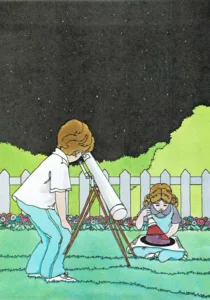
Why do stars twinkle?
The sun and its family of planets, asteroids, meteoroids, and comets are
like tiny specks of dust floating in a gigantic ocean. The endless ocean
of space also contains countless billions of other “specks” ■—the
stars.
Stars shine with a steady glow, just as the sun does. But they seem to
twinkle. Why? Because, when the light from stars reaches our atmosphere,
it gets bent, several times, by layers of moving air.
Five of the “stars” we see in the sky at night are really other planets
in our solar system. They shine because they reflect sunlight. But most
of the stars are other suns, like our sun, that shine with light of
their own. These stars are trillions and trillions of miles (kilometers)
away from us.
The nearest star to us is so far that it takes four years for its light
to reach us. And light travels at the tremendous speed of 186,282 miles
(299,792 kilometers) per second. Some stars are so far that it takes
their light thousands, or even millions, of years to reach us! A twinkle
of light that you see in the sky tonight may have been given off when
dinosaurs lived on earth!
How many stars are there? We don’t know exactly, but scientists believe
there are billions and billions— more stars than there are grains of
sand on all the beaches of the world!
Children sometimes wonder where stars go in the daytime. They don’t “go”
anywhere, of course. They’re still there. It’s just that our daytime sky
is so bright we can’t see the stars.

